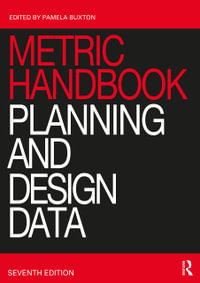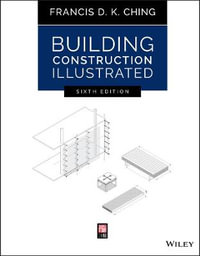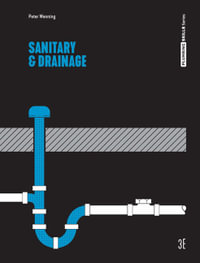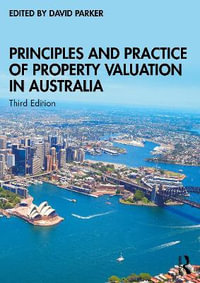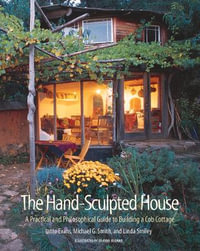
The Hand-Sculpted House
A Practical and Philosophical Guide to Building a Cob Cottage
By: Ianto Evans, Michael G. Smith, Linda Smiley
Paperback | 3 July 2002
At a Glance
346 Pages
3.5 x 16.5 x 23.5
Paperback
RRP $66.50
$61.75
or 4 interest-free payments of $15.44 with
orThe authors build a house the way others create a natural garden. They use the oldest, most available materials imaginable--earth, clay, sand, straw, and water--and blend them to redefine the future (and past) of building. Cob (the word comes from an Old English root, meaning "lump") is a mixture of non-toxic, recyclable, and often free materials. Building with cob requires no forms, no cement, and no machinery of any kind. Builders actually sculpt their structures by hand.
Building with earth is nothing new to America; the oldest structures on the continent were built with adobe bricks. Adobe, however, has been geographically limited to the Southwest. The limits of cob are defined only by the builder's imagination.
Cob offers answers regarding our role in Nature, family and society, about why we feel the ways that we do, about what's missing in our lives. Cob comes as a revelation, a key to a saner world.
Cob has been a traditional building process for millennia in Europe, even in rainy and windy climates like the British Isles, where many cob buildings still serve as family homes after hundreds of years. The technique is newly arrived to the Americas, and, as with so many social trends, the early adopters are in the Pacific Northwest.
Cob houses (or cottages, since they are always efficiently small by American construction standards) are not only compatible with their surroundings, they ARE their surroundings, literally rising up from the earth. They are full of light, energy-efficient, and cozy, with curved walls and built-in, whimsical touches. They are delightful. They are ecstatic.
| Acknowledgments | p. xiii |
| Introduction | p. xv |
| What This Book Offers You | p. xvi |
| About the Authors | p. xvii |
| Questions & Answers about Cob | p. xviii |
| Philosophy, Background, and Design (What You Need to Consider Before You Start to Build) | p. 1 |
| Ianto's Story | p. 3 |
| Peasants and Farmers | p. 4 |
| The Importance of Housing Yourself | p. 5 |
| Natural Building | p. 7 |
| Learning from Nature | p. 8 |
| The Rise of Architects | p. 8 |
| Natural Laws | p. 9 |
| Learning from Conserver Cultures | p. 10 |
| What Are Natural Materials? | p. 14 |
| Unprocessed and Uncombined | p. 14 |
| Primary and Secondary Processing | p. 15 |
| Component Assemblies | p. 16 |
| Why Build With Earth and Other Natural Materials? | p. 16 |
| Health | p. 16 |
| Psychological Well-Being | p. 16 |
| Financial Empowerment | p. 17 |
| Comfort | p. 18 |
| Democracy and Empowerment | p. 18 |
| Tradition and Heritage | p. 19 |
| Durability | p. 19 |
| Environmental Impact | p. 19 |
| Steel Roofs in Kenya | p. 20 |
| The Natural Building Resurgence | p. 21 |
| Where's the Dumpster | p. 22 |
| Oregon Cob | p. 24 |
| A Brief History of Cob | p. 25 |
| Won't Burn Down, Bugs Can't Eat it, and It's Dirt Cheap | p. 26 |
| The Birth of Oregon Cob | p. 28 |
| Cookstoves As Inspiration | p. 29 |
| Our First Cob House | p. 30 |
| Characteristics of Oregon Cob | p. 33 |
| What Cob Does Best | p. 33 |
| Mass Cooler | p. 34 |
| Where Oregon Cob May Be Inappropriate | p. 36 |
| Cob in Hybrid Natural Buildings | p. 37 |
| Cob and Straw Bale Comparison Chart | p. 39 |
| Creative Economics | p. 40 |
| Building for Yourself | p. 40 |
| Thoreau on Shelter | p. 41 |
| Trading Money, Skill, and Time | p. 42 |
| Cheap Housing for Those Who Need It Most | p. 45 |
| Getting Free from the Trap | p. 46 |
| Finding Inexpensive Places to Build | p. 47 |
| Edward's Almost Free House | p. 47 |
| Borrowing Money | p. 48 |
| Checklist: How to Keep Costs Down | p. 49 |
| Interview: Brigitte and Elyse's House | p. 51 |
| Tilt and Spin | p. 54 |
| Watching Earth Turn | p. 55 |
| Some Cosmic Fundamentals | p. 56 |
| A Cosmic Quiz | p. 57 |
| Let Your Home Reflect Cosmic Awareness | p. 57 |
| The Site You Build On | p. 60 |
| Choosing a Suitable Property | p. 61 |
| Consider the Local Bioregion | p. 61 |
| Spend Time on the Land | p. 62 |
| Selecting the Precise Site | p. 63 |
| Create a Master Plan | p. 63 |
| Minimize Ecological Disruption | p. 64 |
| Consider Soils and Drainage | p. 65 |
| Determine the Microclimate | p. 65 |
| Look for a Far Horizon | p. 66 |
| Look for a Dominant Permanent Feature in the Landscape | p. 66 |
| Build on Slopes If Possible | p. 67 |
| Respect Your Neighbors | p. 68 |
| Taking Time | p. 68 |
| Testing Your Choice | p. 68 |
| Dealing with Problem Situations | p. 69 |
| Short of Sun | p. 69 |
| No Trees on Site | p. 70 |
| Noise | p. 70 |
| Invisible Architecture | p. 71 |
| Not Enough Privacy | p. 71 |
| Not a Site for a Cob Building | p. 72 |
| Interview: Eric Hoel's House | p. 73 |
| Designing with Cob | p. 76 |
| The Box Police | p. 76 |
| When the Materials Design the Home | p. 78 |
| A Currency of Pennies | p. 78 |
| Cob's Natural Geometries | p. 79 |
| For Your Edification | p. 80 |
| Thermal Mass | p. 80 |
| Essentials of Passive Solar Design | p. 81 |
| Heating and Cooling Your Building | p. 84 |
| Be Stingy with Glass, Unless Your Climate Is Mild | p. 85 |
| Natural Lighting | p. 86 |
| Catnap Research in a Cob Greenhouse | p. 86 |
| The Heart House | p. 87 |
| Redefining "House" | p. 93 |
| Intuitive Design | p. 93 |
| Dispense with Convention | p. 94 |
| Brainstorm a Lot | p. 94 |
| The Site Was There First! | p. 95 |
| Share Your Home with Nature | p. 95 |
| Keep It Small! | p. 96 |
| Places, Spaces, and Rooms | p. 96 |
| Curved Spaces Feel Bigger: The Case for Round Feet | p. 97 |
| Banish the Old Noun-Rooms | p. 100 |
| Act Out the Dance of Your Daily Life | p. 101 |
| Think Gloves Not Boxes | p. 103 |
| Your Workplace | p. 104 |
| Outdoor Rooms | p. 104 |
| Orient to Earth's Tilt and Spin | p. 106 |
| Make a Model | p. 107 |
| Make an Outline Plan | p. 109 |
| Adjusting the Time-Depth | p. 109 |
| "I Design Old Buildings" | p. 111 |
| Building the Cob Cottage | p. 113 |
| Michael's Story | p. 115 |
| Building a Cob Cottage Step-By-Step | p. 116 |
| Materials and Tools | p. 119 |
| Raw Materials and Where to Get Them | p. 119 |
| The Geological History of Your Site | p. 120 |
| Composition of Soils | p. 120 |
| Determining a Soil's Suitability | p. 122 |
| Sand | p. 123 |
| Clay | p. 124 |
| The Island Without Clay | p. 127 |
| Straw | p. 128 |
| How Much Raw Material Will I Need? | p. 130 |
| Numbers are Not Sizes | p. 131 |
| Finding Other Building Materials | p. 132 |
| Scavenging in the City | p. 133 |
| Scavenging in the Country | p. 134 |
| Tools | p. 134 |
| A Cobber's Tool Kit | p. 135 |
| Hand Tool Reflections | p. 137 |
| Site Respect and Preparation | p. 141 |
| Respect the Deep Ecology of the Site | p. 142 |
| Don't Clear Any Trees Yet | p. 143 |
| Work Slowly, Carefully, by Hand | p. 143 |
| Backhoe Madness in California | p. 145 |
| Work Out the Best Routes for Deliveries | p. 146 |
| Protect Sensitive Areas | p. 146 |
| Walk-in Buildings | p. 146 |
| Site Preparation | p. 147 |
| Dig Test Holes | p. 147 |
| Transfer Your Design onto the Ground | p. 148 |
| Build a Full-Scale Mock-up | p. 150 |
| Drive in Foundation and Datum Stakes | p. 151 |
| Finally, Begin Clearing the Site | p. 151 |
| Erect a Temporary or Permanent Roof | p. 152 |
| Interview: Site as Sanctuary | p. 152 |
| Drainage and Foundations | p. 155 |
| Site Drainage | p. 155 |
| Rubble Trenches | p. 156 |
| Other Drainage Techniques | p. 156 |
| Digging Trenches | p. 157 |
| The Importance of Good Drainage | p. 157 |
| Filling Trenches | p. 158 |
| Foundations | p. 159 |
| Building a Stone Stemwall | p. 161 |
| Experimental Foundations | p. 164 |
| Making the Best Cob | p. 166 |
| How Cob Was Mixed Historically | p. 166 |
| Preparing Clay Soils for Mixing | p. 167 |
| Testing Your Mix | p. 168 |
| The Snowball Test | p. 168 |
| The Crunch Test | p. 168 |
| Test Batches and Test Bricks | p. 169 |
| Mixing Cob on Tarps | p. 170 |
| Notes on Tarps | p. 173 |
| The Pit Method | p. 174 |
| Using Machines for Mixing | p. 175 |
| Mud, Labor, Pleasure | p. 176 |
| Tips for Speed and Efficiency | p. 177 |
| Cob Mix Trouble-Shooting Guide | p. 178 |
| Custom Mixes | p. 178 |
| Building Cob Walls | p. 180 |
| Cobs, Gobs, and Blobs | p. 180 |
| Trodden Cob | p. 182 |
| Cob Loaves | p. 182 |
| Gaab-cob | p. 183 |
| Creating a Monolithic Structure | p. 184 |
| Connecting Two Cob Walls | p. 185 |
| Three Contagious Conditions | p. 186 |
| Wall Thickness | p. 186 |
| Drying | p. 187 |
| Settling | p. 189 |
| Getting It Straight | p. 190 |
| Tapering Walls | p. 191 |
| Trimming Off Excess | p. 191 |
| Tools for Trimming | p. 192 |
| Pipes and Wires | p. 193 |
| Incorporating Other Materials | p. 193 |
| Reaching Higher | p. 194 |
| Scaffolding | p. 195 |
| Second Stories and Up | p. 195 |
| How Fast Can I Build? | p. 195 |
| Sculpting with Cob | p. 197 |
| Sculpting a Whole House | p. 198 |
| Remodeling | p. 199 |
| Built-in Furniture | p. 200 |
| Corbelled Shelves, Arches, and Niches | p. 200 |
| Starter Projects: Garden Benches and Walls | p. 203 |
| Learning and Growing with Garden Walls | p. 204 |
| Earth and Fire: Cob Hearths | p. 206 |
| A Heated Cob Bench | p. 206 |
| Rumford Fireplaces | p. 207 |
| A Lorena Cooking Stove | p. 208 |
| An Earthen Bread Oven | p. 209 |
| Mass Heating Stoves | p. 211 |
| Windows and Doors | p. 212 |
| Keeping the Wall Strong above Openings | p. 212 |
| Connecting Cob to Door and Window Frames | p. 214 |
| Installing Nonopening Windows | p. 216 |
| Replacing Broken Windows | p. 218 |
| Window Placement | p. 219 |
| Windows for Magical Light | p. 219 |
| Windows for View | p. 220 |
| Windows and Solar Gain | p. 221 |
| Windows vs. Ventilators | p. 222 |
| Doors and Doorways | p. 223 |
| Half-Doors | p. 225 |
| Roofs for Cob | p. 227 |
| The Parts of a Roof | p. 228 |
| Roof Design | p. 229 |
| The Shape of a Roof | p. 230 |
| Building a Roof Structure | p. 232 |
| Ceilings | p. 234 |
| Roof Sheathing | p. 235 |
| Living Roofs | p. 235 |
| Thatch | p. 238 |
| Metal Roofing | p. 240 |
| Tiles, Shakes, and Shingles | p. 240 |
| Roof Insulation | p. 242 |
| Wool | p. 243 |
| Straw and Straw-Clay | p. 244 |
| Natural Floors | p. 246 |
| Mass Floors | p. 247 |
| Preparation for a Mass Floor | p. 247 |
| Poured Adobe Floors | p. 249 |
| Tamped Cob Floors | p. 252 |
| An Adobe Block Floor | p. 252 |
| Oil and Wax Finish | p. 253 |
| Other Materials | p. 253 |
| Hydronics and Hypocausts | p. 254 |
| Suspended Floors | p. 255 |
| Plasters and Finishes | p. 257 |
| Exterior Stuccos | p. 258 |
| Don't Use Cement Stucco | p. 259 |
| Interior Plaster | p. 260 |
| Materials for Stuccos and Plasters | p. 260 |
| Inner Light | p. 261 |
| Tools for Plastering and Mixing | p. 262 |
| Preparing a Wall for Stucco or Plaster | p. 263 |
| Earth Plasters | p. 264 |
| General Tips for Plastering | p. 265 |
| One-Coat Kaolin Plaster | p. 266 |
| Litema Clay-Dung Plasters | p. 267 |
| Gypsum | p. 268 |
| Lime-Sand Plasters | p. 269 |
| Washes and Paints | p. 271 |
| Limewash or Whitewash | p. 271 |
| Alis | p. 272 |
| Other Natural Paints | p. 272 |
| Water-Resistant Finishes | p. 274 |
| Onword: Bridging the Inner and Outer Worlds | p. 275 |
| Linda's Story | p. 277 |
| Sculpting Sacred Spaces for Well-Being | p. 279 |
| Intuitive Design and Magic Spots | p. 280 |
| Intuitive Design Exercise | p. 283 |
| Writing in a Magic Spot | p. 284 |
| Make a Model | p. 284 |
| Cob and Health--They Belong Together | p. 285 |
| Mud Dancing | p. 286 |
| Cobbers' Stories about Delight and Quality of Life | p. 288 |
| Joan | p. 288 |
| Mike | p. 289 |
| Elisheva | p. 289 |
| Tricia | p. 290 |
| Relationships and Cob Love Stories | p. 291 |
| A Match Made in Mud: Misha and Elisheva Rauchwerger | p. 291 |
| Earth, Ovens, Art | p. 292 |
| A Mud Artist Soulmate | p. 293 |
| Appendices | p. 295 |
| Common Errors in Cob Construction | p. 295 |
| Codes and Permits | p. 298 |
| Cob and Water | p. 304 |
| Cob and Earthquakes | p. 311 |
| Research Needed | p. 315 |
| Wildlife in the Home | p. 319 |
| Teaching and Learning | p. 323 |
| Glossary | p. 330 |
| Resources on Cob and Natural Building | p. 334 |
| Recommended Books | p. 337 |
| Index | p. 341 |
| Table of Contents provided by Syndetics. All Rights Reserved. |
ISBN: 9781890132347
ISBN-10: 1890132349
Series: Real Goods Solar Living Book
Published: 3rd July 2002
Format: Paperback
Language: English
Number of Pages: 346
Audience: Professional and Scholarly
Publisher: Chelsea Green Publishing Co
Country of Publication: GB
Dimensions (cm): 3.5 x 16.5 x 23.5
Weight (kg): 0.93
Shipping
| Standard Shipping | Express Shipping | |
|---|---|---|
| Metro postcodes: | $9.99 | $14.95 |
| Regional postcodes: | $9.99 | $14.95 |
| Rural postcodes: | $9.99 | $14.95 |
Orders over $79.00 qualify for free shipping.
How to return your order
At Booktopia, we offer hassle-free returns in accordance with our returns policy. If you wish to return an item, please get in touch with Booktopia Customer Care.
Additional postage charges may be applicable.
Defective items
If there is a problem with any of the items received for your order then the Booktopia Customer Care team is ready to assist you.
For more info please visit our Help Centre.
You Can Find This Book In
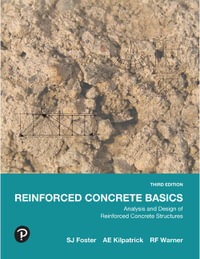
Reinforced Concrete Basics (Pearson Original Edition) 3ed
Analysis and Design of Reinforced Concrete Structures
Paperback
RRP $138.55
$107.75
OFF
This product is categorised by
- Non-FictionArts & EntertainmentArchitectureArchitectural Structure & Design
- Non-FictionEarth Sciences, Geography, Environment, PlanningThe EnvironmentApplied Ecology
- Non-FictionEngineering & TechnologyCivil EngineeringBuilding Skills & Trades
- Non-FictionEngineering & TechnologyCivil EngineeringBuilding Construction & Materials
- Non-FictionHome & House MaintenanceDIY in General











